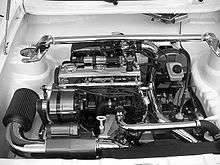Supercharger

 |
1934 Mercedes-Benz W25
|
| Problems playing this file? See media help. | |
A supercharger is an air compressor that increases the pressure or density of air supplied to an internal combustion engine. This gives each intake cycle of the engine more oxygen, letting it burn more fuel and do more work, thus increasing power.
Power for the supercharger can be provided mechanically by means of a belt, gear, shaft, or chain connected to the engine's crankshaft.
When power is provided by a turbine powered by exhaust gas, a supercharger is known as a turbosupercharger[1] – typically referred to simply as a turbocharger or just turbo. Common usage restricts the term supercharger to mechanically driven units.
History
In 1848 or 1849 G. Jones of Birmingham, England brought out a Roots-style compressor.[2]
In 1860, brothers Philander and Francis Marion Roots, founders of Roots Blower Company of Connersville, Indiana, patented the design for an air mover for use in blast furnaces and other industrial applications.
The world's first functional, actually tested[3] engine supercharger was made by Dugald Clerk, who used it for the first[4] two-stroke engine in 1878. Gottlieb Daimler received a German patent for supercharging an internal combustion engine in 1885. Louis Renault patented a centrifugal supercharger in France in 1902. An early supercharged race car was built by Lee Chadwick of Pottstown, Pennsylvania in 1908 which reportedly reached a speed of 100 mph (160 km/h).
The world's first series-produced cars[5] with superchargers were Mercedes 6/25/40 hp and Mercedes 10/40/65 hp. Both models were introduced in 1921 and had Roots superchargers. They were distinguished as "Kompressor" models, the origin of the Mercedes-Benz badging which continues today.
On March 24, 1878 Heinrich Krigar of Germany obtained patent #4121, patenting the first ever screw-type compressor.[6] Later that same year on August 16 he obtained patent #7116 after modifying and improving his original designs. His designs show a two-lobe rotor assembly with each rotor having the same shape as the other. Although the design resembled the roots style compressor, the "screws" were clearly shown with 180 degrees of twist along their length. Unfortunately, the technology of the time was not sufficient to produce such a unit, and Heinrich made no further progress with the screw compressor. Nearly half a century later, in 1935, Alf Lysholm, who was working for Ljungstroms Angturbin AB (later known as Svenska Rotor Maskiner AB or SRM in 1951), patented a design with five female and four male rotors. He also patented the method for machining the compressor rotors.
Types of supercharger
There are two main types of superchargers defined according to the method of gas transfer: positive displacement and dynamic compressors. Positive displacement blowers and compressors deliver an almost constant level of pressure increase at all engine speeds (RPM). Dynamic compressors do not deliver pressure at low speeds; above a threshold speed, pressure increases with engine speed.[7]
Positive displacement
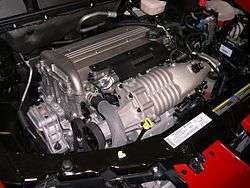

Positive-displacement pumps deliver a nearly fixed volume of air per revolution at all speeds (minus leakage, which is almost constant at all speeds for a given pressure, thus its importance decreases at higher speeds).
Major types of positive-displacement pumps include:
- Roots
- Lysholm twin-screw
- Sliding vane
- Scroll-type supercharger, also known as the G-Lader
Compression type
Positive-displacement pumps are further divided into internal and external compression types.
Roots superchargers are external compression only (although high-helix roots blowers attempt to emulate the internal compression of the Lysholm screw).
- External compression refers to pumps that transfer air at ambient pressure into the engine. If the engine is running under boost conditions, the pressure in the intake manifold is higher than that coming from the supercharger. That causes a backflow from the engine into the supercharger until the two reach equilibrium. It is the backflow that actually compresses the incoming gas. This is an inefficient process and the main factor in the lack of efficiency of Roots superchargers when used at high boost levels. The lower the boost level the smaller is this loss, and Roots blowers are very efficient at moving air at low pressure differentials, which is what they were invented for (hence the original term "blower").
All the other types have some degree of internal compression.
- Internal compression refers to the compression of air within the supercharger itself, which, already at or close to boost level, can be delivered smoothly to the engine with little or no back flow. This is more effective than back flow compression and allows higher efficiency to be achieved. Internal compression devices usually use a fixed internal compression ratio. When the boost pressure is equal to the compression pressure of the supercharger, the back flow is zero. If the boost pressure exceeds that compression pressure, back flow can still occur as in a roots blower. Internal compression blowers must be matched to the expected boost pressure in order to achieve the higher efficiency they are capable of, otherwise they will suffer the same problems and low efficiency of the roots blowers.
Capacity rating
Positive-displacement superchargers are usually rated by their capacity per revolution. In the case of the Roots blower, the GMC rating pattern is typical. The GMC types are rated according to how many two-stroke cylinders, and the size of those cylinders, it is designed to scavenge. GMC has made 2–71, 3–71, 4–71, and the famed 6–71 blowers. For example, a 6–71 blower is designed to scavenge six cylinders of 71 cubic inches (1,163 cc) each and would be used on a two-stroke diesel of 426 cubic inches (6,981 cc), which is designated a 6–71; the blower takes this same designation. However, because 6–71 is actually the engine's designation, the actual displacement is less than the simple multiplication would suggest. A 6–71 actually pumps 339 cubic inches (5,555 cc) per revolution (but as it spins faster than the engine, it can easily put out the same displacement as the engine per engine rev).
Aftermarket derivatives continue the trend with 8–71 to current 16–71 blowers used in different motor sports. From this, one can see that a 6–71 is roughly twice the size of a 3–71. GMC also made 53 cu in (869 cc) series in 2–, 3–, 4–, 6–, and 8–53 sizes, as well as a "V71" series for use on engines using a V configuration.
Dynamic
Dynamic compressors rely on accelerating the air to high speed and then exchanging that velocity for pressure by diffusing or slowing it down.
Major types of dynamic compressor are:
- Centrifugal
- Multi-stage axial-flow
- Pressure wave supercharger
Supercharger drive types
Superchargers are further defined according to their method of drive.
- Belt (V-belt, Synchronous belt, Flat belt)
- Direct drive
- Gear drive
- Chain drive
Temperature effects and intercoolers

One disadvantage of supercharging is that compressing the air increases its temperature. When a supercharger is used on an internal combustion engine, the temperature of the fuel/air charge becomes a major limiting factor in engine performance. Extreme temperatures will cause detonation of the fuel-air mixture (spark ignition engines) and damage to the engine. In cars, this can cause a problem when it is a hot day outside, or when an excessive level of boost is reached.
It is possible to estimate the temperature rise across a supercharger by modeling it as an isentropic process.
- Where:
- = ambient air temperature
- = temperature after the compressor
- = ambient atmospheric pressure (absolute)
- = pressure after the compressor (absolute)
- = Ratio of specific heat capacities = = 1.4 for air
- = Specific heat at constant pressure
- = Specific heat at constant volume
- Where:
For example, if a supercharged engine is pushing 10 psi (0.69 bar) of boost at sea level (ambient pressure of 14.7 psi (1.01 bar), ambient temperature of 75 °F (24 °C)), the temperature of the air after the supercharger will be 160.5 °F (71.4 °C). This temperature is known as the compressor discharge temperature (CDT) and highlights why a method for cooling the air after the compressor is so important.
While it is true that higher intake temperatures for internal combustion engines will ingest air of lower density, this only holds correct for a static, unchanging air pressure. i.e. on a hot day an engine will intake less oxygen per engine cycle than it would on a cold day. However, the heating of the air, while in the supercharger compressor, does not reduce the density of the air due to its rise in temperature. The rise in temperature is due to its rise in pressure. Energy is being added to the air and this is seen in both its energy, internal to the molecules (temperature) and of the air in static pressure, as well as the velocity of the gas.
Inter-cooling makes no change in the density of the air after it has been compressed. It is only removing the thermal energy of the air from the compression process. i.e. the inter-cooler only removes the energy put in by the compression process and does not alter the density of air, so that the air/fuel mixture is not so hot that it causes it to ignite before the spark ignites it, otherwise known as pre-ignition.
Two-stroke engines
For two-stroke engines, scavenging is required to purge exhaust gasses. In small engines this is commonly achieved by using the crankcase as a blower, the descending piston during the power stroke compresses air in the crankcase used to purge the cylinder. Scavenging blowing should not be confused with supercharging, no charge compression takes place. As the volume change produced by the lower side of the piston is the same as the upper face, this is limited to scavenging and cannot provide any supercharging.
Larger engines usually use a separate blower for scavenging and it was for this type of operation that the Roots blower was developed. Historically many designs of blower have been used, from separate pumping cylinders, 'top hat' pistons combining two pistons of different diameter the larger one being used for scavenging, various rotary blowers and centrifugal turbocompressors, including turbochargers. Turbocharging two-stroke engines is difficult, but not impossible, as an exhaust-driven turbocharger does not provide any boost until it has had time to spin up to speed. Purely turbocharged two stroke engines may thus have difficulty when starting, with poor combustion and dirty exhausts, possibly even four-stroking. Some two-stroke turbochargers have a mechanical drive through a clutch, used for starting.
Simple two-stroke engines with ported inlet and exhaust cannot be supercharged since the inlet port always closes first. For this reason, two-stroke Diesel engines usually have mechanical exhaust valves with separate timing to allow supercharging. Regardless of this, two-stroke engines require scavenging at all engine speeds and so turbocharged two-stroke engines must still employ a blower, usually Roots type. This blower may be mechanically or electrically driven, in either case the blower may be disengaged once the turbocharger starts to deliver air.
Automobiles
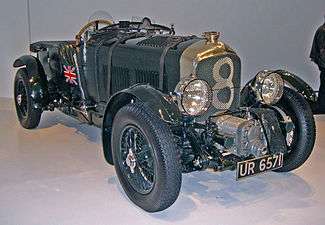
In 1900, Gottlieb Daimler, of Daimler-Benz (Daimler AG), was the first to patent a forced-induction system for internal combustion engines, superchargers based on the twin-rotor air-pump design, first patented by the American Francis Marion Roots in 1860, the basic design for the modern Roots type supercharger.
The first supercharged cars were introduced at the 1921 Berlin Motor Show: the 6/20 hp and 10/35 hp Mercedes. These cars went into production in 1923 as the 6/25/40 hp (regarded as the first supercharged road car[8]) and 10/40/65 hp.[9] These were normal road cars as other supercharged cars at same time were almost all racing cars, including the 1923 Fiat 805-405, 1923 Miller 122[10] 1924 Alfa Romeo P2, 1924 Sunbeam,[11] 1925 Delage,[12] and the 1926 Bugatti Type 35C. At the end of the 1920s, Bentley made a supercharged version of the Bentley 4½ Litre road car. Since then, superchargers (and turbochargers) have been widely applied to racing and production cars, although the supercharger's technological complexity and cost have largely limited it to expensive, high-performance cars.
Supercharging versus turbocharging
Keeping the air that enters the engine cool is an important part of the design of both superchargers and turbochargers. Compressing air increases its temperature, so it is common to use a small radiator called an intercooler between the pump and the engine to reduce the temperature of the air.
There are three main categories of superchargers for automotive use:
- Centrifugal turbochargers – driven from exhaust gases.
- Centrifugal superchargers – driven directly by the engine via a belt-drive.
- Positive displacement pumps – such as the Roots, Twin Screw (Lysholm), and TVS (Eaton) blowers.
Roots blowers tend to be only 40–50% efficient at high boost levels; by contrast centrifugal (dynamic) superchargers are 70–85% efficient at high boost. Lysholm-style blowers can be nearly as efficient as their centrifugal counterparts over a narrow range of load/speed/boost, for which the system must be specifically designed.
Mechanically driven superchargers may absorb as much as a third of the total crankshaft power of the engine and are less efficient than turbochargers. However, in applications for which engine response and power are more important than other considerations, such as top-fuel dragsters and vehicles used in tractor pulling competitions, mechanically driven superchargers are very common.
The thermal efficiency, or fraction of the fuel/air energy that is converted to output power, is less with a mechanically driven supercharger than with a turbocharger, because turbochargers use energy from the exhaust gas that would normally be wasted. For this reason, both economy and the power of a turbocharged engine are usually better than with superchargers.
Turbochargers suffer (to a greater or lesser extent) from so-called turbo-spool (turbo lag; more correctly, boost lag), in which initial acceleration from low RPM is limited by the lack of sufficient exhaust gas mass flow (pressure). Once engine RPM is sufficient to raise the turbine RPM into its designed operating range, there is a rapid increase in power, as higher turbo boost causes more exhaust gas production, which spins the turbo yet faster, leading to a belated "surge" of acceleration. This makes the maintenance of smoothly increasing RPM far harder with turbochargers than with engine-driven superchargers, which apply boost in direct proportion to the engine RPM. The main advantage of an engine with a mechanically driven supercharger is better throttle response, as well as the ability to reach full-boost pressure instantaneously. With the latest turbocharging technology and direct gasoline injection, throttle response on turbocharged cars is nearly as good as with mechanically powered superchargers, but the existing lag time is still considered a major drawback, especially considering that the vast majority of mechanically driven superchargers are now driven off clutched pulleys, much like an air compressor.
Turbocharging has been more popular than superchargers among auto manufacturers owing to better power and efficiency. For instance Mercedes-Benz and Mercedes-AMG previously had supercharged "Kompressor" offerings in the early 2000s such as the C230K, C32 AMG, and S55 AMG, but they have abandoned that technology in favor of turbocharged engines released around 2010 such as the C250 and S65 AMG biturbo. However, Audi did introduce its 3.0 TFSI supercharged V6 in 2009 for its A6, S4, and Q7, while Jaguar has its supercharged V8 engine available as a performance option in the XJ, XF, XKR, and F-Type, and, via joint ownership by Tata motors, in the Range Rover also.
Twincharging
In the 1985 and 1986 World Rally Championships, Lancia ran the Delta S4, which incorporated both a belt-driven supercharger and exhaust-driven turbocharger. The design used a complex series of bypass valves in the induction and exhaust systems as well as an electromagnetic clutch so that, at low engine speeds, boost was derived from the supercharger. In the middle of the rev range, boost was derived from both systems, while at the highest revs the system disconnected drive from the supercharger and isolated the associated ducting.[13] This was done in an attempt to exploit the advantages of each of the charging systems while removing the disadvantages. In turn, this approach brought greater complexity and impacted on the car's reliability in WRC events, as well as increasing the weight of engine ancillaries in the finished design.
The Volkswagen TSI engine (or Twincharger) is a 1.4-litre direct-injection motor that also uses both a supercharger and turbocharger.
Aircraft
Altitude effects
.jpg)
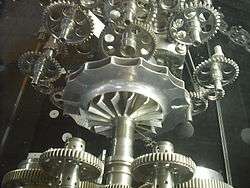
Superchargers are a natural addition to aircraft piston engines that are intended for operation at high altitudes. As an aircraft climbs to higher altitude, air pressure and air density decreases. The output of a piston engine drops because of the reduction in the mass of air that can be drawn into the engine. For example, the air density at 30,000 ft (9,100 m) is 1⁄3 of that at sea level, thus only 1⁄3 of the amount of air can be drawn into the cylinder, with enough oxygen to provide efficient combustion for only a third as much fuel. So, at 30,000 ft (9,100 m), only 1⁄3 of the fuel burnt at sea level can be burnt.[14] (An advantage of the decreased air density is that the airframe experiences only about 1/3 of the aerodynamic drag. Plus, there is decreased back pressure on the exhaust gases.[15] On the other hand, more energy is consumed holding an airplane up with less air in which to generate lift.)
A supercharger can be thought of either as artificially increasing the density of the air by compressing it or as forcing more air than normal into the cylinder every time the piston moves down.[14]
A supercharger compresses the air back to sea-level-equivalent pressures, or even much higher, in order to make the engine produce just as much power at cruise altitude as it does at sea level. With the reduced aerodynamic drag at high altitude and the engine still producing rated power, a supercharged airplane can fly much faster at altitude than a naturally aspirated one. The pilot controls the output of the supercharger with the throttle and indirectly via the propeller governor control. Since the size of the supercharger is chosen to produce a given amount of pressure at high altitude, the supercharger is oversized for low altitude. The pilot must be careful with the throttle and watch the manifold pressure gauge to avoid overboosting at low altitude. As the aircraft climbs and the air density drops, the pilot must continuously open the throttle in small increments to maintain full power. The altitude at which the throttle reaches full open and the engine is still producing full rated power is known as the critical altitude. Above the critical altitude, engine power output will start to drop as the aircraft continues to climb.
Effects of temperature
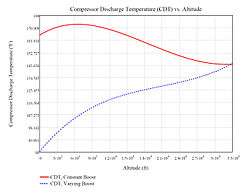
As discussed above, supercharging can cause a spike in temperature, and extreme temperatures will cause detonation of the fuel-air mixture and damage to the engine. In the case of aircraft, this causes a problem at low altitudes, where the air is both denser and warmer than at high altitudes. With high ambient air temperatures, detonation could start to occur with the manifold pressure gauge reading far below the red line.
A supercharger optimized for high altitudes causes the opposite problem on the intake side of the system. With the throttle retarded to avoid overboosting, air temperature in the carburetor can drop low enough to cause ice to form at the throttle plate. In this manner, enough ice could accumulate to cause engine failure, even with the engine operating at full rated power. For this reason, many supercharged aircraft featured a carburetor air temperature gauge or warning light to alert the pilot of possible icing conditions.
Several solutions to these problems were developed: intercoolers and aftercoolers, anti-detonant injection, two-speed superchargers, and two-stage superchargers.
Two-speed and two-stage superchargers
In the 1930s, two-speed drives were developed for superchargers. These provided more flexibility for the operation of the aircraft, although they also entailed more complexity of manufacturing and maintenance. The gears connected the supercharger to the engine using a system of hydraulic clutches, which were initially manually engaged or disengaged by the pilot with a control in the cockpit. At low altitudes, the low-speed gear would be used in order to keep the manifold temperatures low. At around 12,000 feet (3,700 m), when the throttle was full forward and the manifold pressure started to drop off, the pilot would retard the throttle and switch to the higher gear, then readjust the throttle to the desired manifold pressure. Later installations automated the gear change according to atmospheric pressure.
Another enhancement was the use of two compressors (also known as stages) in series, such two-stage superchargers were also always two-speed. After the air was compressed in the low-pressure stage, the air flowed through an intercooler radiator where it was cooled before being compressed again by the high-pressure stage and then possibly also aftercooled in another heat exchanger. Two-stage compressors provided much improved high altitude performance, as typified by the Rolls-Royce Merlin powered Supermarine Spitfire Mk IX and the North American Mustang. In some two-stage systems, damper doors would be opened or closed by the pilot in order to bypass one stage as needed. Some systems had a cockpit control for opening or closing a damper to the intercooler/aftercooler, providing another way to control temperature. Rolls-Royce Merlin engines had fully automated boost control and all the pilot had to do was advance the throttle, the control system would limit boost as necessary until maximum altitude was reached.
Turbocharging
A mechanically driven supercharger has to take its drive power from the engine. Taking a single-stage single-speed supercharged engine, such as the Rolls-Royce Merlin, for instance, the supercharger uses up about 150 hp (110 kW). Without a supercharger, the engine could produce about 750 horsepower (560 kilowatts), but with a supercharger, it produces about 1,000 hp (750 kW)—an increase of about 400 hp (750 - 150 + 400 = 1000 hp), or a net gain of 250 hp (190 kW). This is where the principal disadvantage of a supercharger becomes apparent. The engine has to burn extra fuel to provide power to drive the supercharger. The increased air density during the input cycle increases the specific power of the engine and its power-to-weight ratio, but at the cost of an increase in the specific fuel consumption of the engine. In addition to increasing the cost of running the airplane this has the potential to reduce its overall range. On the other hand, with more engine power the airplane can carry more fuel. In military types, this has often been done using external drop tanks, for example in the American P-38 Lightning, P-47 Thunderbolt, P-51 Mustang, and F6F Hellcat fighter planes.
With their external fuel tanks and supercharged or turbocharged engines, the P-38 and the P-51 could fly from England to Berlin and back, the P-47 could fly from England to the Ruhr and back, and the F6F had the longest range of any fighter based on aircraft carriers of the war. Also, the P-51 could fly even further - from Iwo Jima to Tokyo and back. These ranges were much longer than those of any Nazi German, British, Japanese, Canadian, or Soviet fighter planes of World War II. These American fighters also had excellent fighting performance at high altitudes.
As opposed to a supercharger driven by the engine itself, a turbocharger is driven using the exhaust gases from the engines. The amount of power in the gas is proportional to the difference between the exhaust pressure and air pressure, and this difference increases with altitude, helping a turbocharged engine to compensate for changing altitude.
The majority of high-altitude aircraft engines used during World War II used mechanically driven superchargers, because these had three significant manufacturing advantages over turbochargers. Turbochargers - used by large American aircraft engines such as the Allison V-1710 (used in the P-38) and the Pratt & Whitney R-2800, required additional ducting expensive high-temperature metal alloys in the gas turbine and preturbine section of the exhaust system, but they were very useful in high-altitude bombers and some fighter planes. The size of the ducting alone was a serious problem. For example, both the F4U Corsair and the P-47 Thunderbolt used the same multicylinder radial engine, but the large barrel-shaped fuselage of the P-47 was needed because of the amount of ducting to and from the turbocharger in the rear fuselage. The F4U used a two-stage supercharger with compact intercooler layout.
Turbocharged piston engines are also subject to many of the same operating restrictions as those of gas turbine engines. Turbocharged engines also require frequent inspections of their turbochargers and exhaust systems to search for possible damage caused by the extreme heat and pressure of the turbochargers. Such damage was a prominent problem in the early models of the American B-29 Superfortress high-altitude bombers used in the Pacific Theater of Operations during 1944–45.
Turbocharged piston engines continued to be used in a large number of postwar airplanes, such as the B-50 Superfortress, the KC-97 Stratofreighter, the Boeing Stratoliner, the Lockheed Constellation, and the C-124 Globemaster II.
In more recent times most aircraft engines for general aviation (light airplanes) are naturally aspirated, but the smaller number of modern aviation piston engines designed to run at high altitudes use turbocharger or turbo-normalizer systems, instead of a supercharger driven from the crank shafts. The change in thinking is largely due to economics. Aviation gasoline was once plentiful and cheap, favoring the simple but fuel-hungry supercharger. As the cost of fuel has increased, the ordinary supercharger has fallen out of favor. Also, depending on what monetary inflation factor one uses, fuel costs have not decreased as fast as production and maintenance costs have.
Effects of fuel octane rating
Until the late 1920s all automobile and aviation fuel was generally rated at 87 octane or less. This is the rating that was achieved by the simple distillation of "light crude" oil. Engines from around the world were designed to work with this grade of fuel, which set a limit to the amount of boosting that could be provided by the supercharger, while maintaining a reasonable compression ratio.
Octane rating boosting through additives was a line of research being explored at the time. Using these techniques, less valuable crude could still supply large amounts of useful gasoline, which made it a valuable economic process. However, the additives were not limited to making poor-quality oil into 87-octane gasoline; the same additives could also be used to boost the gasoline to much higher octane ratings.
Higher-octane fuel resists auto ignition and detonation better than does low-octane fuel. As a result, the amount of boost supplied by the superchargers could be increased, resulting in an increase in engine output. The development of 100-octane aviation fuel, pioneered in the USA before the war, enabled the use of higher boost pressures to be used on high-performance aviation engines, and was used to develop extremely high-power outputs – for short periods – in several of the pre-war speed record airplanes. Operational use of the new fuel during World War II began in early 1940 when 100-octane fuel was delivered to the British Royal Air Force from refineries in America and the East Indies.[16] The German Luftwaffe also had supplies of a similar fuel.[17][18]
Increasing the knocking limits of existing aviation fuels became a major focus of aero engine development during World War II. By the end of the war, fuel was being delivered at a nominal 150-octane rating, on which late-war aero engines like the Rolls-Royce Merlin 66[19][20] or the Daimler-Benz DB 605DC developed as much as 2,000 hp (1,500 kW).[21][22]
See also
- Boost gauge
- History of the internal combustion engine
- Jet engine
- Naturally aspirated engine
- Ram-air intake
- Turbofan
- Turbojet
- Twincharger
Notes
- ↑ "''"The Turbosupercharger and the Airplane Power Plant"''". Rwebs.net. 1943-12-30. Retrieved 2010-08-03.
- ↑ https://books.google.co.uk/books?id=tOxIAQAAIAAJ&dq=Lobe+Pump+Roots+1854&focus=searchwithinvolume&q=Jones
- ↑ Ian McNeil, ed. (1990). Encyclopedia of the History of Technology. London: Routledge. pp. 315–321. ISBN 0-203-19211-7.
- ↑ "Forgotten Hero: The man who invented the two-stroke engine". David Boothroyd, The VU. Archived from the original on 2004-12-15. Retrieved 2005-01-19.
- ↑ Georgano, G.N. (1982). The new encyclopedia of motorcars 1885 to the present (ed.3. ed.). New York: Dutton. p. 415. ISBN 0-525-93254-2.
- ↑ "TECHNOLOGY - Whipple Superchargers". whipplesuperchargers.com. Retrieved 2015-10-23.
- ↑ Twin-screw vs. Centrifugal Supercharging Kenne Bell
- ↑ "1923 Mercedes 6/25/40 hq". mercedes-benz-classic.com/content. Retrieved 2009-01-21.
- ↑ "Gottlieb Daimler, Wilhelm Maybach and the "Grandfather Clock"". benzinsider.com/2008. Retrieved 2009-01-21.
- ↑ "1923 Miller 122 Supercharged". sportscarmarket.com. Retrieved 2009-01-21.
- ↑ "History of Sunbeam cars". rootes-chrysler.co.uk. Retrieved 2009-01-21.
- ↑ "Automobiles Delage, Courbevoie-sur-Seine". kolumbus.fi/leif.snellman. Retrieved 2009-01-21.
- ↑ "D&W Performance Air Induction - Performance Products to Increase Vehicle Performance". Dwperformance.com. Retrieved 2014-03-04.
- 1 2 Smallwood 1995, p.133.
- ↑ Northrop 1955, p.111
- ↑ Payton-Smith 1971, pp. 259–260.
- ↑ Mankau and Petrick 2001, pp. 24–29.
- ↑ Griehl 1999, p. 8.
- ↑ Price, 1982. p. 170.
- ↑ Berger & Street, 1994. p. 199.
- ↑ Mermet 1999, pp. 14–17.
- ↑ Mermet 1999, p. 48.
References
- White, Graham. Allied Aircraft Piston Engines of World War II: History and Development of Frontline Aircraft Piston Engines Produced by Great Britain and the United States during World War II. Warrendale, Penn: Society of Automotive Engineers, Inc.; Shrewsbury, England: Airlife Publishing Ltd.; 1995. ISBN 1-56091-655-9, ISBN 1-85310-734-4.
External links
| Wikimedia Commons has media related to Superchargers. |
- How Superchargers Work by Bill Harris at HowStuffWorks.com.
- Vintage Superchargers (via archive.org)
- He Harnessed a Tornado – and developed a modern airplane supercharger, a large article from Popular Science, June 1941.
- The History of Screw Compressors by Whipple Superchargers.
- "Development of the Aircraft Supercharger" a 1943 Flight article
